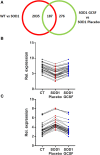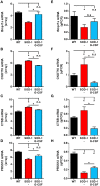Gene expression changes in spinal motoneurons of the SOD1(G93A) transgenic model for ALS after treatment with G-CSF
- PMID: 25653590
- PMCID: PMC4299451
- DOI: 10.3389/fncel.2014.00464
Gene expression changes in spinal motoneurons of the SOD1(G93A) transgenic model for ALS after treatment with G-CSF
Abstract
Background: Amyotrophic lateral sclerosis (ALS) is an incurable fatal motoneuron disease with a lifetime risk of approximately 1:400. It is characterized by progressive weakness, muscle wasting, and death ensuing 3-5 years after diagnosis. Granulocyte-colony stimulating factor (G-CSF) is a drug candidate for ALS, with evidence for efficacy from animal studies and interesting data from pilot clinical trials. To gain insight into the disease mechanisms and mode of action of G-CSF, we performed gene expression profiling on isolated lumbar motoneurons from SOD1(G93A) mice, the most frequently studied animal model for ALS, with and without G-CSF treatment.
Results: Motoneurons from SOD1(G93A) mice present a distinct gene expression profile in comparison to controls already at an early disease stage (11 weeks of age), when treatment was initiated. The degree of deregulation increases at a time where motor symptoms are obvious (15 weeks of age). Upon G-CSF treatment, transcriptomic deregulations of SOD1(G93A) motoneurons were notably restored. Discriminant analysis revealed that SOD1 mice treated with G-CSF has a transcriptom close to presymptomatic SOD1 mice or wild type mice. Some interesting genes modulated by G-CSF treatment relate to neuromuscular function such as CCR4-NOT or Prss12.
Conclusions: Our data suggest that G-CSF is able to re-adjust gene expression in symptomatic SOD1(G93A) motoneurons. This provides further arguments for G-CSF as a promising drug candidate for ALS.
Keywords: ALS; G-CSF; gene expression; laser microdissection; motoneuron; mouse model; neurodegeneration.
Figures




Similar articles
-
Analytical sequence to study G-CSF effect on the transcriptome of isolated spinal motoneurons from SOD1 G93A mice, an animal model for amyotrophic lateral sclerosis.Genom Data. 2015 Feb 28;4:47-9. doi: 10.1016/j.gdata.2015.02.003. eCollection 2015 Jun. Genom Data. 2015. PMID: 26484174 Free PMC article.
-
Granulocyte-colony stimulating factor improves outcome in a mouse model of amyotrophic lateral sclerosis.Brain. 2008 Dec;131(Pt 12):3335-47. doi: 10.1093/brain/awn243. Epub 2008 Oct 3. Brain. 2008. PMID: 18835867 Free PMC article.
-
Granulocyte Colony-Stimulating Factor Ameliorates Skeletal Muscle Dysfunction in Amyotrophic Lateral Sclerosis Mice and Improves Proliferation of SOD1-G93A Myoblasts in vitro.Neurodegener Dis. 2017;17(1):1-13. doi: 10.1159/000446113. Epub 2016 Aug 20. Neurodegener Dis. 2017. PMID: 27544379
-
Voltage-gated calcium channels are abnormal in cultured spinal motoneurons in the G93A-SOD1 transgenic mouse model of ALS.Neurobiol Dis. 2016 Sep;93:78-95. doi: 10.1016/j.nbd.2016.04.009. Epub 2016 May 2. Neurobiol Dis. 2016. PMID: 27151771 Free PMC article.
-
The vulnerability of spinal motoneurons and soma size plasticity in a mouse model of amyotrophic lateral sclerosis.J Physiol. 2018 May 1;596(9):1723-1745. doi: 10.1113/JP275498. Epub 2018 Mar 26. J Physiol. 2018. PMID: 29502344 Free PMC article.
Cited by
-
Granulocyte-colony stimulating factor (G-CSF): an emerging therapeutic approach for amyotrophic lateral sclerosis (ALS).Acta Neurol Belg. 2023 Jun;123(3):763-771. doi: 10.1007/s13760-022-01996-z. Epub 2022 Jun 23. Acta Neurol Belg. 2023. PMID: 35737276 Review.
-
Disrupting SOD1 activity inhibits cell growth and enhances lipid accumulation in nasopharyngeal carcinoma.Cell Commun Signal. 2018 Jun 11;16(1):28. doi: 10.1186/s12964-018-0240-3. Cell Commun Signal. 2018. PMID: 29891006 Free PMC article.
-
Analytical sequence to study G-CSF effect on the transcriptome of isolated spinal motoneurons from SOD1 G93A mice, an animal model for amyotrophic lateral sclerosis.Genom Data. 2015 Feb 28;4:47-9. doi: 10.1016/j.gdata.2015.02.003. eCollection 2015 Jun. Genom Data. 2015. PMID: 26484174 Free PMC article.
-
The Granulocyte-colony stimulating factor has a dual role in neuronal and vascular plasticity.Front Cell Dev Biol. 2015 Aug 7;3:48. doi: 10.3389/fcell.2015.00048. eCollection 2015. Front Cell Dev Biol. 2015. PMID: 26301221 Free PMC article. Review.
-
Inhibition of β-Glucocerebrosidase Activity Preserves Motor Unit Integrity in a Mouse Model of Amyotrophic Lateral Sclerosis.Sci Rep. 2017 Jul 12;7(1):5235. doi: 10.1038/s41598-017-05313-0. Sci Rep. 2017. PMID: 28701774 Free PMC article.
References
-
- Averill S., Michael G. J., Shortland P. J., Leavesley R. C., King V. R., Bradbury E. J. (2004). NGF and GDNF ameliorate the increase in ATF3 expression which occurs in dorsal root ganglion cells in response to peripheral nerve injury. Eur. J. Neurosci. 19, 1437–1445. 10.1111/j.1460-9568.2004.03241.x - DOI - PubMed
-
- Cahoy J. D., Emery B., Kaushal A., Foo L. C., Zamanian J. L., Christopherson K. S., et al. . (2008). A transcriptome database for astrocytes, neurons, and oligodendrocytes: a new resource for understanding brain development and function. J. Neurosci. 28, 264–278. 10.1523/JNEUROSCI.4178-07.2008 - DOI - PMC - PubMed
LinkOut - more resources
Full Text Sources
Other Literature Sources
Molecular Biology Databases
Miscellaneous

